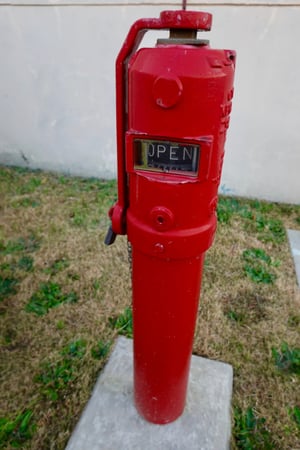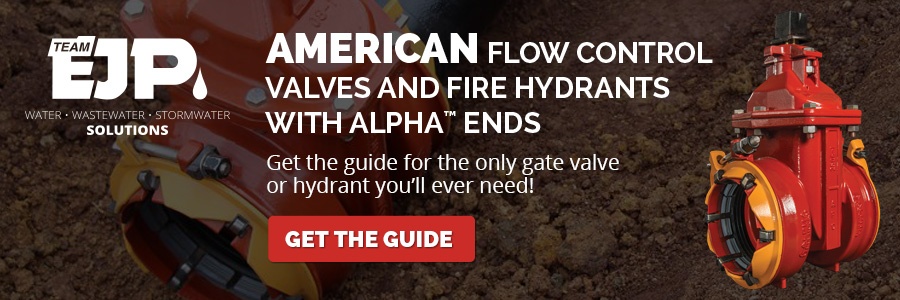Adding a Post Indicator Valve to Always Know Valve Position
- Home
- Team EJP Blog
- Adding a Post Indicator Valve to Always Know Valve Position
- Sep 16, 2020 10:30:00 AM
- Everett J. Prescott
*Updated 09/17/20*
When you work in water utilities, there are always some valves that you want to know the position of, whether for fire suppression, frequently-exercised valves or those that require a very fast response to an emergency situation. One option you could consider is adding a Post Indicator Valve, or PIV, to that part of your system. But what is it, how does it work and where should you add it? In this post, we'll discuss some of the range of options and benefits of the American Flow Control IP16 Indicator Post Valve to help get you started.
 Available to work with gate valves between 3" and 24", American Flow Control's IP16 heavy-duty valves are used with automatic sprinkler and wet standpipe systems to make it simple for firefighters and other emergency responders to quickly ascertain whether the valve is open or shut. The handle is typically located on top of the post and is locked in either the open or closed position when not in use, creating a slim profile to prevent anything from catching on it accidentally.
Available to work with gate valves between 3" and 24", American Flow Control's IP16 heavy-duty valves are used with automatic sprinkler and wet standpipe systems to make it simple for firefighters and other emergency responders to quickly ascertain whether the valve is open or shut. The handle is typically located on top of the post and is locked in either the open or closed position when not in use, creating a slim profile to prevent anything from catching on it accidentally.
PIVs will typically include some form of adjustment, so they can be used to retrofit an existing valve if you have a paving or construction project that is expected to impede access to your existing gate valves. They can also be adjusted to a wide range of gate valves from different manufacturers, providing that the valve adjustment head and the PIV's wrench end match, as the indicator blank can be adjusted up or down into the correct position for that particular combination. This can be accomplished in the field without too much trouble, allowing your crew to implement this type of system.
What Makes the American Flow Control IP16 Post Indicator Valve Stand Out
 At Team EJP, we're always looking for water utility solutions that help make your job easier so that you can get on with your task list, and that's one of the reasons we want to bring the American Flow Control IP16 Indicator Post to your attention. On this PIV, the indicator sign is available on both sides of the post, making it easier to discover the position of the valve. It also includes the capability of locking the valve into the open position to prevent tampering when water flow is needed most, while also having the capability to add an electric supervisory switch for remote monitoring of the valve's position.
At Team EJP, we're always looking for water utility solutions that help make your job easier so that you can get on with your task list, and that's one of the reasons we want to bring the American Flow Control IP16 Indicator Post to your attention. On this PIV, the indicator sign is available on both sides of the post, making it easier to discover the position of the valve. It also includes the capability of locking the valve into the open position to prevent tampering when water flow is needed most, while also having the capability to add an electric supervisory switch for remote monitoring of the valve's position.
The post is roughly 6.25" wide and an above-ground height of 36.78", while the amount of post beneath the ground is fully customizable, allowing you to specify exactly how far below the ground your post indicator will go. An available handwheel extends the width at the very top to 14", while the electric supervisory switch fits in through a 1/2" NPT fitting, making it easy to find the other components you need for installation. Three different models cover a wide range of valve diameters between 3" to 24" and handling a number of trench depths from 2'1" to 22'4". It can be customized to open with standard counterclockwise or clockwise motion as indicated by the pre-cast arrow at the top of the post using either a wrench or handwheel.
For the indicator signs, Model A is factory set for a 6" valve, Model B is factory set for a 16" valve and Model C is factory set for a 24" valve, but all of the models can be adjusted to other valve sizes through a relatively simple process. This allows you to adjust the point at which the SHUT signs appear in the indicator post window to the specific valve that you've chosen to use.
Beyond fire suppression systems, you could also include PIVs in a wide range of areas where you've faced frequent maintenance or breaks in the past, which allows your crew to tell at a glance whether the valve is open or closed so that they can quickly move it into the necessary position without a lot of guesswork. By incorporating PIVs from American Flow Control into your water utility's fire suppression and critical infrastructure systems, you have the assurance that at a single glance, the position of the valve can be instantly determined. But what if you don't know whether it will work well with your existing system or you're not quite sure which valve to put into place for new construction being added to your system? The experienced professionals at Team EJP are ready to help. Please feel free to contact us today with any questions, for further details or to discover which valve is the right option for your needs.








